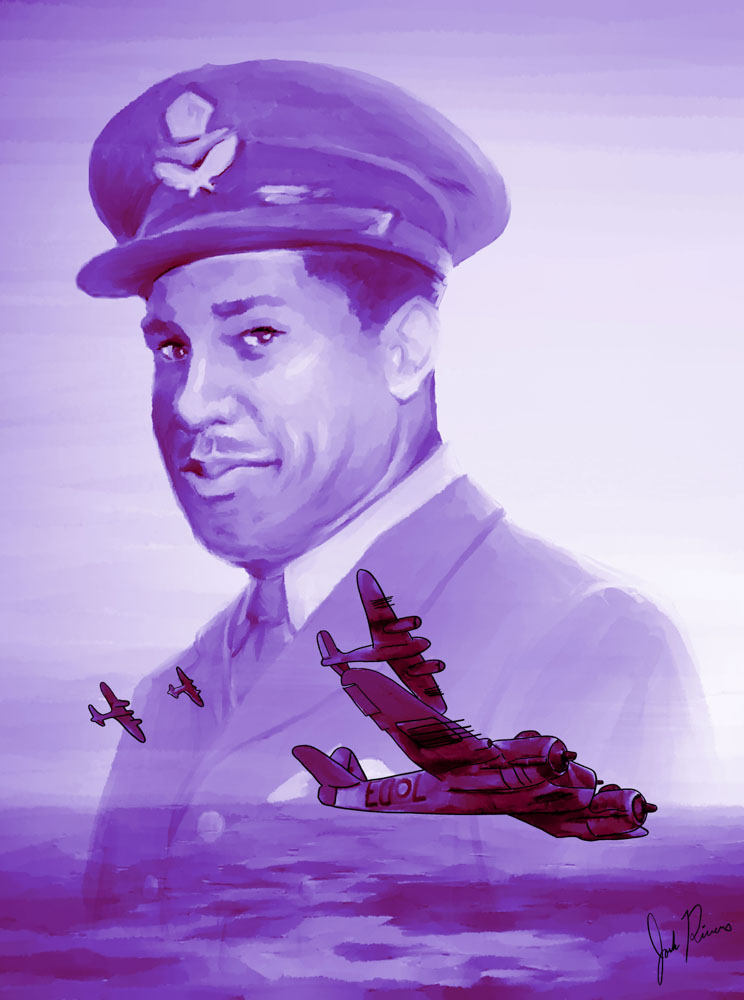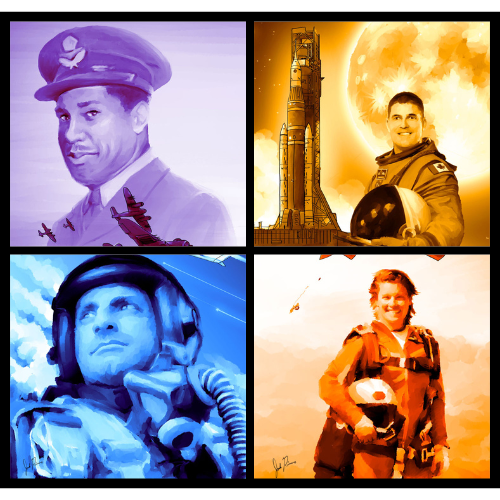Members of the Royal Canadian Air Force (RCAF) have greatly contributed to the aviation field both in Canada and around the world. In collaboration with the RCAF Foundation, Honouring Bravery and Je Me Souviens would like to share some of these stories with you. If you are interested in reading more stories like this, check out the RCAF Foundation’s latest book: Aviation Nation.

Soaring Beyond Racial Bias
Allan Bundy was a trailblazer. Through pure grit and determination, he became Canada’s first Canadian-born Black fighter pilot in the RCAF.
At the outbreak of the Second World War, Allan was training to be a doctor, but decided he wanted to fly planes. He enlisted in the RCAF. But back in 1939, people of “non-European” descent were not allowed to be pilots or aircrew; instead they were assigned general duties as a cook, clerk, or a driver.
Allan insisted he be allowed to fly with the RCAF. On March 31, 1942, the Air Force removed its biased recruiting policies and Allan’s determination paid off. He earned his wings that same year at the top of his class. Allan joined 404 Squadron, known as the “Buffaloes.” The Buffaloes fought against German submarines using planes like the Bristol Beaufighter. These planes were difficult to fly and needed a navigator.
At first, no one would fly with Allan because of his skin colour. But he quickly earned his squadron’s respect as a skilled pilot and Sergeant Elwood “Lefty” Wright became his navigator. Together, they went on to complete 42 successful missions.
Allan Bundy overcame great odds to serve Canada. He changed cultural attitudes, proving that skills and bravery can triumph over racial discrimination.

Over the Moon
Canadian Space Agency (CSA) astronaut Colonel Jeremy Hansen is not just any astronaut; he’s one of four astronauts representing the CSA at NASA. In 2023, he was assigned to fly around the Moon!
Being an astronaut is a dream come true for Jeremy. After joining the Air Cadet program, he got both his glider and private pilot licences. Jeremy learned about space science and physics at the
Royal Military College, and then became a fighter pilot. He flew CF-18 jets and completed NORAD operations in the Arctic. Jeremy was selected by the CSA in 2009 and he graduated from Astronaut
Candidate Training at NASA in 2011.
Jeremy was a capcom at NASA’s Mission Control Center, the person who talks to astronauts on the International Space Station from the ground. Jeremy also learned how to live in space-like conditions and has spent time living both underground and underwater! He was the first Canadian to be entrusted with leading a NASA
astronaut class, which means that he was in charge of training astronaut candidates from the United States and Canada.
When space calls, Colonel Jeremy Hansen will be ready. He is currently preparing for the Artemis II mission, the first crewed flight test of the Orion spacecraft. He’ll be the first Canadian ever to orbit
the Moon!

Never Stop Looking Up!
Jameel has had a blast living life in the fast lane for most of his career! His journey from Air Cadet to becoming Canada’s tenth professional astronaut started at a young age. While attending airshows with his father and brother, Jameel knew he wanted to become a fighter pilot. After learning about Chris Hadfield, Jameel set his sights higher—to the stars.
At 16 years old, he had already begun his flying career in a glider over a southern Alberta field. It took hard work, dedication to excellence, and a lot of time in the air, but 30 years later, Jameel has flown over 5,300 hours in more than 65 different aircraft, including Virgin Galactic’s spaceship Unity and mothership Eve, the F-16 Viper, CF-18 Hornet, Tornado GR4, and the F-15 Eagle. In this span of time, Jameel flew as a fighter pilot with the RCAF,
completed 84 combat missions with Britain’s Royal Air Force, and graduated top of the class from the U.S. Air Force Test Pilot School.
In 2020, the world’s first commercial space company, Virgin Galactic, selected Jameel as one of its spaceline pilots. After years of training, Jameel flew Spaceship Unity to 287,011 feet at a speed of Mach 2.96. He is the first Canadian astronaut to fly a winged rocket ship to space.
Looking at Earth from space was profound for Jameel. He loves to share his experience with young aviators, as well as his motto: To never stop looking up!

Trailblazing SAR
Search and Rescue Technicians (SAR Techs) are Canada’s “angels in orange jumpsuits.” The highly skilled survival experts specialize in extreme rescue on land and at sea. Becoming one is not easy. That
is because it’s one of the military’s most dangerous jobs.
Each year, thousands apply but only around 30 people are chosen to take the two-week pre-selection course. From this group, 12 to 16 candidates are accepted into the 11-month SAR training course. Here, they become survivalists of Arctic, ocean, or bush conditions.
Ever since she was seventeen, Tammy Negraeff wanted to be a SAR Tech. After joining the Canadian Armed Forces, taking courses, and building up her strength, Tammy felt ready to apply. Her determination paid off. Tammy was accepted into the challenging SAR course and graduated in 1998—the first Canadian woman to become a SAR Tech.
Posted to Cold Lake, Alberta, a day at the office for Tammy might involve repelling into a ravine, parachuting from a helicopter, or snowshoeing across a mountainside. Now retired, for Tammy, the
best parts of her job were saving lives and reuniting families.
Being bold and committed paid off. Tammy overcame many obstacles to blaze the trail for other women interested in a career in search and rescue.
For more information on the RCAF Foundation’s classroom resources for Aviation Nation, click here.
Images courtesy of RCAF Foundation Illustrator Josh River. Excerpts of Aviation Nation, by Michael Hood and Tom Jenkins, reprinted with the permission of the RCAF Foundation.

